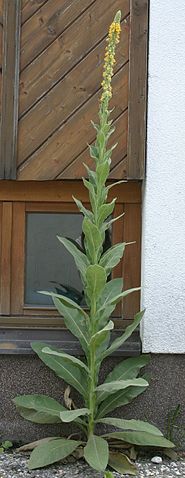Weeds and Worms – more on Mullein
Topic #1: Mullein
Photo by Sebastian Stabinger Courtesy Wikimedia Commons
Photo by Olivier Pichard Courtesy Wikimedia Commons
Mullein—Uses and Mitigation
The following is from the U.S. Forest Service monograph on mullein.
(The numbers below identify the original sources listed in the monograph.)
Uses
Deer, elk, mountain goats, and small mammals feed on common mullein…
European cultures had a variety of uses for common mullein. These many uses likely encouraged the early transport and introduction of this species into nonnative areas…
In as early as the 4th century BC, yellow common mullein flowers were used to dye hair [64]. Romans dipped flowering stalks in tallow and used them as torches [66]. In a review of folk medicine, common mullein was said to be used to treat respiratory disorders such as asthma, tuberculosis, bronchitis, and pneumonia; to combat tumor formation; and to treat urinary tract infections and skin diseases. Hemorrhoids, diarrhea, warts, migraines, frost bite, and ringworm were also treated with common mullein [137]. In Europe, concoctions of common mullein leaves and roots were used to treat many respiratory and alimentary conditions [10].
Native Americans also utilized common mullein. Southwestern tribes, including the Hopi, smoked dried common mullein leaves and…other plants to treat mental illness [66,67]. Potawatomis, Mohegans, Penobscots, and Menominess smoked dried common mullein leaves to treat colds, bronchitis, and asthma. Catawbas made a cough syrup from boiled common mullein roots, and a poultice of mashed leaves was used to relieve bruises, wounds, and sprains. Choctaws used a poultice of leaves for headaches [10].
Early European settlers in the eastern United States used common mullein seed to sting or poison fish. Common mullein seeds were crushed and put into diked areas of slow moving water. Fish breathing was severely reduced or stopped by the toxic seeds. Fish “stings” were an easy method of food collection and often turned into community events. Sometime before the Revolutionary War, common mullein seeds were brought from Europe and cultivated for this purpose [148]. Colonial women rubbed common mullein leaves on their cheeks to redden them [146].
Today common mullein is one of several plants used in herbal ear drops used to treat earaches in children (>5 years) [119]. Common mullein leaves and flowers, capsules, alcohol extracts, and flower oil are available for medicinal use in the United States, and a recent (2002) study of common mullein extracts revealed antibacterial and antitumor properties [136,137]. In a Northwest floral guide, basal common mullein leaves are noted as potential insoles for weary hikers [104].
Mitigation
For mitigation on open space areas, the USFS says: “Increased levels and frequencies of disturbances may increase the density of the common mullein seed bank. In northern Arizona, the density of common mullein seedlings emerging from soil samples increased with increased levels of past land use.” Of course the Four Mile Fire was the main past disturbance here, in addition to past mining and ag land use.
They go on to say: “Physical control methods may be an effective method of removing small aboveground common mullein populations. Plants severed through the root crown below the basal leaves do not sprout [16]. Flowering stalks should be removed from the site to limit additions to the seed bank.”
Mullein is a List C species. The management plan for List C species, as stated on the state website “will not be to stop the continued spread of these species but to provide additional education, research, and biological control resources to jurisdictions that choose to require management of List C species.”
Some people have offered to have a mullein pull this summer. Stay tuned.

